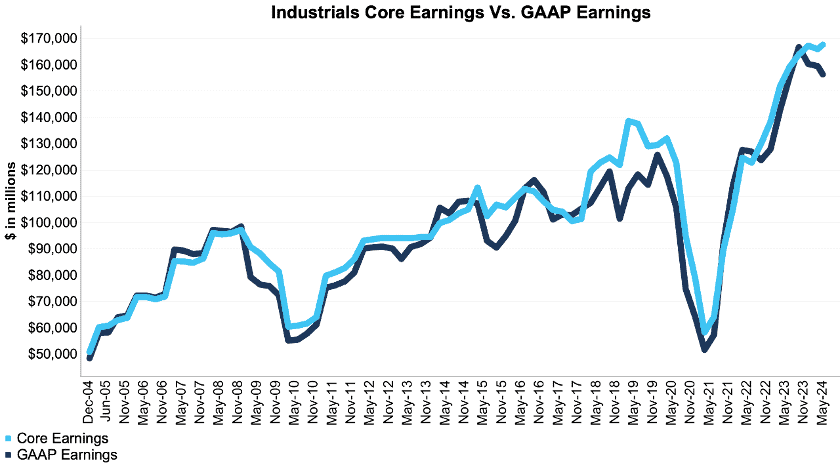Results for Core Earnings and GAAP earnings are different again this quarter and raise red flags about the quality of reported earnings. These results underscore the more stable nature of Core Earnings. Because we remove unusual gains and losses, Core Earnings are not as volatile as GAAP Earnings.
This report is an abridged and free version of S&P 500 & Sectors: GAAP vs Core Earnings Update for 1Q24, one of our quarterly series of reports on fundamental market and sector trends. The full reports are available to Institutional members.
The full version of the report analyzes Core Earnings[1],[2] and GAAP earnings for the S&P 500 and each of its sectors (last analysis is here) from 2004 to present.
This report leverages our cutting-edge Robo-Analyst technology to deliver proven-superior[3] fundamental research and support more cost-effective fulfillment of the fiduciary duty of care.
GAAP Earnings Fall Understates Profits in 1Q24
Our superior fundamental data protects investors from being fooled by misleading trends in un-scrubbed GAAP Earnings. The recent fall in GAAP Earnings, the first QoQ decline since 4Q22, explains part of Wall Street’s uncertainty about interest rates and our belief that pockets of quality stocks remain in the market. Core Earnings for the S&P 500 in the TTM ended 1Q24 sit at record highs going back to 2004.
We’ve seen in the past that companies understate GAAP earnings in uncertain times (kitchen sink effect) to set up easy comps moving forward. This phenomenon occurred most recently from 1Q22 through 4Q22, when GAAP earnings significantly understated Core Earnings. Could companies be in the early stages of kitchen sink quarters again? It is not uncommon the understated GAAP earnings to presage a stock market correction. We’ll be watching closely to see if the fall in GAAP earnings continues in 2Q24 while Core Earnings continue to rise. See Figure 1 in the full report.
GAAP Earnings[4] Understate Core Earnings for Over Half of the S&P 500 (by Market Cap)
59% of the companies in the S&P 500 reported GAAP Earnings that are lower than Core Earnings for the TTM ended 1Q24.
When GAAP Earnings understate Core Earnings, they do so by an average of 54%, per Figure 1.
Figure 1: S&P 500 GAAP Earnings Understated by 54% On Average
Sources: New Constructs, LLC and company filings.
We use Funds from Operations (FFO) for Real Estate companies rather than GAAP Earnings.
The 296[5] companies with understated GAAP Earnings make up 55% of the market cap of the S&P 500 as of May 16, 2024. Companies with understated GAAP earnings also made up 55% of the S&P 500 market cap in 4Q23 and 64% of the S&P 500 market cap in 1Q23.
Figure 2: Understated Earnings as % of Market Cap: 2012 through 5/16/24
Sources: New Constructs, LLC and company filings.
Key Details on Select S&P 500 Sectors
Seven of eleven sectors saw a QoQ rise in Core Earnings through the TTM ended 1Q24.
The Consumer Cyclicals sector saw the largest QoQ improvement in Core Earnings.
The Technology sector generates the most Core Earnings. On the flip side, the Real Estate sector has the lowest Core Earnings.
Below we highlight the Industrials sector and a stock with some of the most negative Earnings Distortion (i.e. understated GAAP earnings) in the sector.
Sample Sector Analysis[6]: Industrials Sector
Figure 3 shows Core Earnings for the Industrials sector, at $167.6 billion, rose 1% QoQ in 1Q24, while GAAP earnings, at $156.3 billion, fell 2% over the same time.
Figure 3: Industrials Core Earnings Vs. GAAP: 2004 – 1Q24
Sources: New Constructs, LLC and company filings.
Our Core Earnings analysis is based on aggregated TTM data for the sector constituents in each measurement period.
The May 16, 2024 measurement period incorporates the financial data from calendar 1Q24 10-Qs, as this is the earliest date for which all the calendar 1Q24 10-Qs for the S&P 500 constituents were available.



